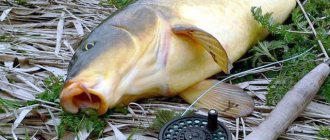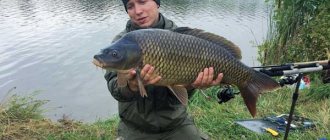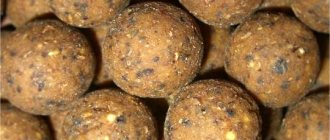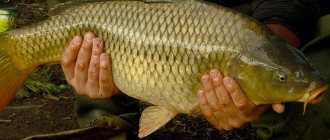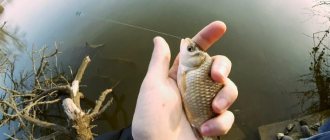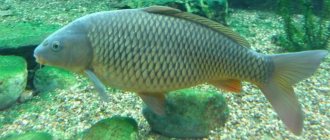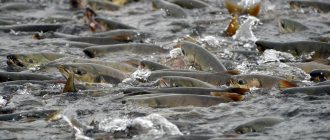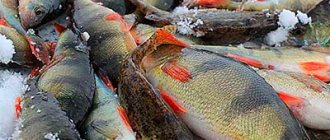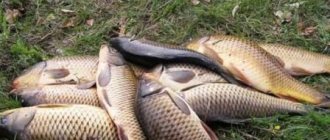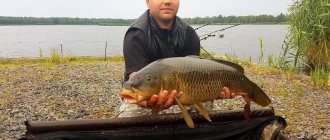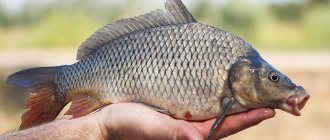Catching carp in spring in cold water
Carp fishing in spring begins around April-May, when the water temperature reaches 10 degrees. Typically, spring fishing is carried out on small rivers, where fish enter from lakes and ponds. The bite at this time is poor; the fish prefers animal food.
Best baits for cold water:
- worm;
- bunches of maggots.
An improvement in carp biting is observed only in late spring after the fish spawn. Sometimes zhor comes only at the beginning of summer. But in the spring you can catch a record trophy, so the tackle must be strong and reliable.
You need to look for fish in the shallows, where the sun warms the spring water.
The bait should be thrown in small portions so as not to saturate the fish. The use of fatty bait mixtures in the spring is unacceptable.
Features of fishing in spring, summer and autumn
It is worth planning a carp hunt when the water in the reservoir warms up by at least 10 degrees. In such conditions, the fish actively begins to be interested in food and move around the water area. This time falls on the beginning of April - November. Depending on temperature fluctuations, the intensity of bites will vary greatly.
Spring
The beginning of the full feeder season is April. It is worth exploring sun-warmed shallows and clean places in the reservoir. The first bites come from small fish, and trophy specimens become more active in warmer water.
Among the baits that work well are baits of animal origin:
- maggot;
- bloodworm;
- worm.
When fishing on a feeder in the spring, chopped worms, crushed bloodworms, and maggots must be added to the bait mixture. The immobilized components in the composition do not alarm cautious fish in any way, which is an advantage for the angler. In addition, they stay longer at a specific point. Hunting for carp can be done throughout the daylight hours. Sunny days are considered successful.
Summer
During the hot period of the year, the carp bite is characterized as stable. But due to the abundance of food supply, the fish becomes capricious and picky. Instead of maggots and worms, the fish prefers corn kernels and pearl barley. Feeder installation should be more elegant, with sufficient sensitivity.
It is worth looking for carp at a considerable distance from the shore; hunting is possible at medium distances, in holes up to 2 m deep. When it gets colder, the number of bites noticeably decreases. It is ideal to plan fishing in the morning and evening, or at night in extreme heat. If the weather is cloudy, there is light rain, then there is a chance to fish successfully all day.
Autumn
As the air temperature drops, carp move to deeper parts of the reservoir. He tries to be on the edges of holes, near underwater ravines. Autumn fishing on a feeder - fishing at depth. You should expect a bite closer to lunch or evening. If the morning is cold, then there may not be a bite at all.
At this time, baits of animal origin are effective. The consistency of the bait mixture should be viscous. If the day turns out to be sunny, then you need to look for fish in the shallows where the water is warm.

Using reliable and balanced gear for carp fishing on a feeder, the angler increases his chances not only of a qualitative, but also a quantitative catch. This process is so exciting that it is worth preparing for it. It is not easy to cope with such a rival as carp; you will have to make an effort and acquire several options for bait. By experimenting with them, you can quickly figure out what is promising. It is equally effective to use a carp feeder on platoons, lakes, and rivers. And you shouldn’t skimp on bait; it’s hard to overfeed carp.
Fishing for carp in summer, features of carp behavior in warm water
Summer is the best time of the year for carp fishing. As the water warms up, the fish becomes more active, and the carp's appetite improves.
The best time for fishing in summer is early morning and late evening, and on the hottest days - at night.
In hot weather, you need to look for fish in deep holes, thickets of reeds and reeds, near underwater springs. Here the fish hides from the scorching sun.
A good bite is observed during a summer thunderstorm, in cloudy weather with drizzling rain, and with falling atmospheric pressure. The bite intensifies the day before weather conditions improve.
In summer, it is necessary to catch carp at a depth of 2 to 5 meters.
The best baits for carp fishing in summer are vegetable baits. Since ancient times, fishermen have used:
- corn;
- potatoes;
- peas;
- bread.
And recently boilies have become popular. In summer, carp are fed mixtures with large plant fractions:
- cereal grains;
- peas;
- potato.
The most promising places for carp fishing
So, it is immediately important to select a body of water in which carp will be found. Note that this fish is found in many reservoirs, but not in all. Why? There are many reasons, for example, unfavorable living conditions (low oxygen content, lack of deep areas, poor food supply, polluted water).
Most often, carp are found in rivers with clean running water, as well as in ponds and lakes. Recently, carp have begun to be bred in artificial ponds, where paid fishing is organized. Let us note that in such water areas it will not be very difficult to catch trophy carp.
Most of all, carp loves areas of water with a moderate current or if there is no current at all. When choosing a place to fish for carp, you first need to take into account weather conditions and time of year. Among the most promising areas for carp fishing are:
- Thickets of reeds and reeds in the coastal zone with a depth of one meter;
- Snagged areas of the water area, especially near exits from deep holes;
- Places with sharp changes in depth, whirlpools;
- Areas with sandy or clay bottom;
- Among flooded or fallen trees;
- On the windward coast (in the evening or early in the morning, may appear during the day);
The listed areas are promising, but it is important to note that regardless of this, it is important to take weather conditions into account. The warmer the water, the deeper parts of the water area you will need to look for carp and vice versa.
Read: What to use to catch carp in the fall?
Equipment and selection of nozzles
Anglers use a wide variety of gear to catch carp. These are classic float rods such as match and plug. In bottom fishing, feeder gear is the leader. In addition, there are many fishing homemade products that successfully help carp. For example:
- bottom fishing rods equipped with a spring or nipple;
- old donk models with elastic;
- fishing with mugs from a boat.
There are many suitable baits and baits for carp fishing. These are corn and peas, worms and maggots, dough and boilies.
It is better to put several maggots, peas or corn grains on the hook. And for attaching boilies, hair installation is used. Various types of dough are well recommended in carp fishing: hominy, mastyrka, etc.
As before, carp are caught using young boiled potatoes. In summer, dragonflies and grasshoppers, large flies, and cabbage worms are used to catch fish in aquatic vegetation. In each body of water, carp have their own preferred baits and baits.
Carp fishing: fishing basics
Finding the right place to catch carp is half the battle. It is also important to properly prepare the gear and the fishing area. Therefore, for fishing to be effective, you will first need to feed the chosen place. Any bait is suitable for this, the main composition of which will contain coarsely fractionated feed.
If there is a current at the fishing site, then the bait is mixed with a small amount of clay, after which balls the size of a tennis ball are formed (they must be dense so that they do not break when hitting the water) and sent into the water.
It is recommended to start feeding the area at least a day in advance, but if it doesn’t work out, it’s okay, carp will be suitable for bait for a maximum of an hour. During fishing, bait is used depending on the activity of the carp. If the bite is weak or absent, then it would not be a bad idea to send 2-3 balls of bait to the fishing points.
Now that the place has been baited, you can begin setting up the camp and preparing gear. You can catch carp using: a donkey, a feeder, a fly rod, a spring, a float rod. The listed gear differs in its features and advantages. The choice of a certain option should be based on the conditions in the fishing area, as well as the time of year.
Having baited the place and prepared the gear for catching bait, you can attach the bait to the hook and throw the equipment into the water. Note that for carp fishing, baits are again selected taking into account the time of year and weather conditions. You can catch carp using various types of vegetable baits (bread crumb, pearl barley, corn, peas, wheat, boiled potatoes, dough). And also using bait of animal origin (maggots, worms).
Experienced carp anglers, when going carp fishing, take with them at least 5-7 bait options, since it is difficult to predict in advance what the carp will bite well on today. In addition, boilies are suitable for fishing, which today are offered in a large assortment in fishing stores.
Fishing with a float rod
The float fishing rod is equipped with a 5-meter rod with a test from 10 to 30 grams, a reel with a spool size of 2500 with 100 meters of fishing line with a thickness of 0.25 mm.
For the leash you will need monofilament with a diameter of 0.2 mm, and its length depends on the fishing conditions (usually 1-1.5 m).
The load capacity of the floats is selected within the range of 2-8 g. Sliding installation is most often used. Sinkers can be placed on different types of fishing line, be it pellets or lead twists.
The hook is selected according to the bait used, usually numbers 10, 8 and 6.
The right float tackle for catching crucian carp - how to load the float and choose baits.
Catching wild carp and carp on a feeder - secrets and fishing tactics.
Another way of catching carp is on the top, unsportsmanlike, but effective.
Feeder equipment for carp
The best bottom tackle is a feeder.
It comes with a rod with a plug connection and a sensitive tip. The length of the rod is 2.5-3 meters with a cast weight of up to 100 g, which allows you to make long casts. The weight of the feeder depends on the casting distance and fishing depth. If fishing is carried out at a distance of less than 30 m, then instead of a feeder, an olive sinker weighing 20-30 grams is mounted.
The reel with the baitrunner system is equipped with a 0.25 mm fishing line. The length of the leash is between 30-80 cm.
Guide to fishing for carp on a feeder - how to make equipment, choose a place, the best baits, baits and groundbait for carp fishing.
How to catch crucian carp on a feeder - the answer is in this article.
How to make an ordinary zakidushka donka in three ways.
Equipment
To catch carp, you can use various types of feeder equipment, but there are several that are especially catchy and popular.
- Method. A feeder is used in the form of a frame or lattice, covered with bait on all sides. It turns out something like a ball of bait, inside of which there is a hook with bait. In the water, the bait gradually disintegrates, and the carp, sucking it in, swallows the hook.
- Paternoster. The easiest feeder equipment to manufacture. Also contributing to its popularity is its high sensitivity. Well suited for bottoms covered with silt, which is often found when fishing on a pond. Installation of such equipment will take no more than 10 minutes.
When fishing for carp on a feeder, the main role in the equipment is played not by the method of tying, but by the correct selection of the feeder.
- Spring. The bait, which is wrapped around a spirally twisted wire, is easily washed away by water, luring fish. By retracting it, the fish reaches the hook with bait.
- Frame. The principle is the same as that of the “spring”, only the wire is replaced by plastic “wings”. This type of feeder is good when fishing in the grass, as the “wings” help to slide well between the stems, avoiding snags and fish slipping off.
- Flat. Refers to method feeders. Carp fishing on a flat feeder is gaining popularity among fishermen. The feeder has a flat bottom, which is ideal for silted and grassy bottoms. Short leashes are used - up to 10 cm. As with spring fishing, the bait sticks around the feeder, while the hook hides inside. There are two types of installation of a flat feeder:
- blind (flat method) - a feeder stopped on a leash plays the role of a sinker, thanks to which the fish hooks itself. For self-hooking of carp to be successful, you should use feeders of 30 grams or more.
- inline flat - the feeder is locked with a rubber stopper on the main line or the leash swivel. But more often it moves freely along the fishing line. This type of installation does not imply self-cutting.
- Closed. Suitable when using animal bait. Usually it looks like a cylinder with small holes through which live bait (maggots, worms, bloodworms) gradually creeps out.
You can use other types of feeders - it all depends on the characteristics of the reservoir and fishing conditions.
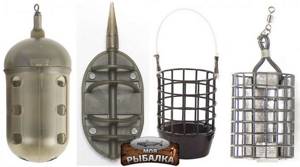
How to fish on a paid pond?
Fishing in a pond has some peculiarities. For a reasonable fee, the fisherman has the opportunity to hone his skills on a reservoir rich in fish, where carp is the master.
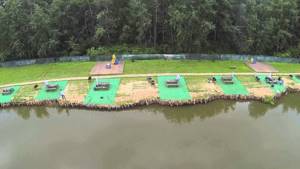
But here it is not always possible to tempt the carp to bite. The fact is that here the carp have the opportunity to eat well. Therefore, an angler needs to have about 10-15 different baits in order to find the key to the fish. Groundbait does not always have to look like bait.
Sometimes carp are attracted by the sweet aroma of the bait mixture, and are caught using a worm or maggot.
Little secrets of carp fishing
In the process of carp fishing, many anglers have developed their own secret tricks.
One of these tricks is used to give boilies buoyancy. It is better to fish with such baits in muddy areas of ponds and lakes. Those who prepare boilies themselves achieve buoyancy by adding foam or cork crumbs to the mixture.
If the boilie is purchased in a store, there is another way to give it buoyancy. Cylindrical inserts 5 mm thick are cut from cork. A hole is made in the boilie with a drill of the same diameter. Now all that remains is to insert the cork cylinder into the boilie hole. This bait will not sink in a thick layer of silt.
A guide to catching carp with boilies, the best flavors and cooking recipes.
Carp boilies Mainline
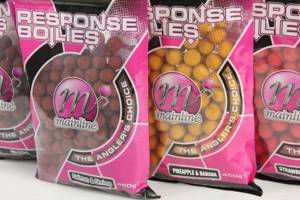
Features of carp fishing
- It is important to remember that carp is a very cautious and shy fish. Therefore, when you come to a pond, you should try to maintain silence during the fishing process. Unless necessary, do not come closer than a meter to the water. If the carp notices the fisherman, then you won’t have to count on a good bite, since the fish may leave the area. Carp can be frightened not only by loud noise, but also by a shadow falling from the fisherman or bright clothing.
- After casting baits, the rods should be securely fastened to the shore, otherwise the carp can easily drag them into the water. It is recommended to use special metal stands to hold fishing rods, which are offered in an assortment of sizes in fishing stores.
- The carp carefully approaches the bait; it can savor it for a long time or simply push it from side to side, which will be noticeable by the slight tremor of the rod tip. There is no need to rush in such cases; it is important to wait for the moment when the carp sucks in the bait with the hook, and only after that can you hook and be sure that the trophy is securely hooked.
- When planning carp fishing, you need to prepare 2-3 places at once and always be ready for the transition. You should change the fishing point in any case if no bites occur within 2 hours after throwing the bait. However, this rule must be observed in the morning and evening hours; there is no need to rush to change places during the day.
- The places chosen for carp fishing should be started to be fed at least 24 hours in advance. This must be done using bait, the main composition of which is supplemented with part of the bait that is selected for fishing. For greater efficiency, it is recommended to mix the bait with clay, especially if fishing is carried out at great depths or there is a current in the selected area.
Read: Features of summer carp fishing
As for the time of day, carp bite best early in the morning and towards sunset. It should also be remembered that the best activity of carp will always be in warm water; the peak of activity is observed from May to mid-July.
However, if the main goal is to catch a trophy carp, then it should be noted that the greater chance of catching it is not in the beginning or middle of summer, but in the first half of autumn. It is during this period that he begins to actively feed, preparing for the winter cold, forgetting about caution and becoming less capricious and picky about food.
Fishing with a rubber band
The old method of fishing with bottom tackle with an elastic band allows you to solve some of the problems of carp anglers.
Firstly, it is convenient to fish with such gear at night, and secondly, the donka can be equipped with several leashes, which will increase the fishable water area.
- Typically, a fly rod with an elastic band consists of a short spinning rod with a reel.
- An elastic band with a heavy weight is mounted at the end of the main line.
- From the elastic band, at a distance of 40-70 cm, install 5-6 leashes made of monofilament with a diameter of 0.2-0.25 mm.
The length of the elastic is selected for a specific location, and is determined by such a parameter as the stretch coefficient. So, with a coefficient of 3, the length of an elastic band of 20 m can stretch up to 60 m. It is best to bring the finished tackle to the fishing point by boat. A bell or a soft rod tip can act as a bite alarm.
Spring fishing
Long before the advent of the feeder, anglers caught carp using bottom tackle with a spring.
The spring is a feeder made of wire with a diameter of 1.8-2.2 mm. A tube is mounted inside the spring, through which the main fishing line 0.3 mm thick is passed. Leashes can be tied directly to the spring or to the main line.
For fishing, dough-like porridge is used, which is used to fill the spring. Balls of dough or other bait cling to hooks No. 2-4. The hooks are recessed inside the spring, and the entire spring is covered with mush so that the hooks are hidden.
The line on the leads should have less breaking force than the main line. The rod and reel can be used the same as when fishing with an elastic band.
The process of catching carp on a feeder
Fishing with a feeder is not particularly difficult, so even a beginner can do it. Of course, it is worth studying the sequence of actions first.
- The tackle is completely assembled, the bait is attached to the hook, and the feeder is filled with bait.
- The cast is made to the fishing point. In this case, during casting, the rod is directed upward; when the feeder touches the surface of the water, it must be smoothly lowered forward and placed on the stand.
- The tip of the rod should put slight tension on the line. This is applicable when fishing with conventional, rather than self-hooking equipment.
- The friction brake is weakened so that during the first jerk the carp does not tear the rod from its place, and the fishing line is easily released from the spool.
- A bite is expected.
If there is no bite for a long time, then you should re-throw the tackle. This must be done every 10-15 minutes.
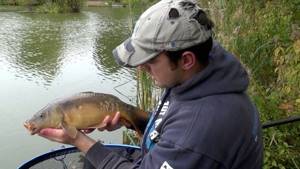
Fishing for carp in currents and still water
Carp is a very common fish and is found in various bodies of water, but it prefers still water. On any body of water, the angler must first find a fishing point, which is usually an uneven bottom topography that attracts fish - a hole, an edge or a hill. At the same time, fishing tactics have their own nuances.
- In still water, the fishing area is pre-fed. The rod is positioned horizontally on the stand, and the bite alarm is fixed on the fishing line.
- When fishing in a body of water with a current - on a river or canal - bait should be thrown constantly at intervals of 5-6 minutes. When using light feeders, the rod should be installed vertically. The tip of the tackle will act as a bite alarm.
Non-sports tackle "nipple"
A type of bottom tackle for carp fishing is a nipple. This is the name of a kind of feeder, which is made from wire, a tablespoon, a cap from a plastic bottle, etc.
The principle of the gear is similar to a spring:
- Several leashes with hooks are attached to the nipple.
- The nipple is stuffed with thick porridge or dough in which the hooks are hidden.
- The carp sucks up the porridge from the feeder along with the hooks and is hooked.
You can improve the bite by attaching a foam ball to the hook. It is important to secure the rod well to the shore and loosen the reel clutch. Then, when a carp bites, you won’t have to fish a fishing rod in a pond.
Feeding
The future fishing area must be pre-fed. Fishing for carp on a feeder involves several feeding methods, depending on the distance:
- If the distance from the shore is small, then it is enough to throw 5-7 balls of bait by hand.
- For long distances you will have to use a slingshot, but it shoots at a distance of up to 50-60 meters.
- If you don’t have a slingshot or a distance of more than 60 meters, you will have to use a bait feeder. During the first 5-6 casts, the feeders are released just below the surface of the water, 2/3 of the bait should lie on the bottom, and the rest of the mixture remains for fishing.
- Feeding using a carp rocket. A special feature of this feeder is the float head. When it gets into the water, it floats upside down, and the food loaded inside is poured out exactly to the designated place.
The bait feeder together with the bait has a lot of weight, so the rod involved in feeding should be of the heavy or extra heavy class. For complementary feeding, you can use any cheap rod to save the main feeder rod.
Saving bait when feeding can lead to a lack of catch. On average, starting feeding takes about 2 kilograms of mixture.
